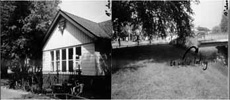
Cityscapeeast
This story is the compilation of two lectures presented at the International Institute of Social History
( 09122002) in Amsterdam and at the NGE ( Dutch Assemble of Esthetics,10042003) in Witte de Wit, Rotterdam.
Ladies and gentlemen,
On behalf of Buro jan-ZE I'd like to welcome you to this talk on the cityscapeeast
project.
Buro jan-ZE is a web of varying form and composition, pursuing
the question: How long is a thought? (How far does a thought extend?)
In this network people work alongside and with each other without loss of
their own background and methods. Whatever Buro jan-ZE does is determined
by what is happening around us and what we perceive to be important in our
own lives at the time of cooperation.
Cityscapeeast is about the repercussions of historical events on the public domain in urban landscapes. A shift in context occurs in space and time in relation to the project and hence a shift in significance. The images from cityscapeeast are imbedded in other stories. The story I'm about to tell you will guide you through the imbedding and brief history of cityscapeeast itself. Cityscapeeast is taking you on an expedition. Bon voyage.
A characteristic way of perceiving, observing and describing a city would be to say: "this is where X used to be ", and it would feel as if it were there still.(1) It forms the city behind her current presentation. Cityscapeeast is a document reminding that X once stood here, tickling one's imagination and stimulating memory. But also, it works as her antidote. The results are merely what they are, in their own form in present reality.
They become our traces in a city full of traces. Which traces did cityscapeeast leave?
 |
The project's first exhibition was held at Ankeroog adjacent to the drainage canal, which borders on the East Indonesian District in Amsterdam. The exhibition carried the title howfareastistheeastindonesiandistrict? and was based on the concepts of velocity of circulation and velocity of rotation.
At that point cityscapeeast concerned itself with the change in eastern
parts of town in North European cities.
Due to the dominant western wind in the North of Europe in the industrial
era these parts mainly used to be characterised by shipyards, stinking industry
and cheap working-class neighbourhoods. After the fall of the wall and in
the digital era there's a slow but unmistakable facelift taking place of
these citylandscapes.
Think of the Docklands in London, Tony Blair's milleniumtent which can
be now seen in the tv series Eastenders' introduction, trendy galleries
are opening their doors in Paris Est and last but not least: where East
Berlin used to be, now lies Das Mitte.
In Amsterdam large scale new-construction building took place. But had ideas
regarding the East actually changed?
The newly built upon islands carry street names from the Indonesian Archipelago.
Even so, the islands are never included in the East Indonesian District.
For the East Indonesian District was East Amsterdam en many new estate dwellers
did not want that association.
As such, a North-South division occurred in East Amsterdam, the border being
the drainage canal. The North being the new estate and the South the poor
old part of town.
Within the district council of Zeeburg (in Amsterdam) there was a feeling
that the old East Indonesian District inhabitants might feel neglegted.
In the year 2000, when the East Indonesian District had existed for a 100
years, the district council wanted to put this neighbourhood in the limelight.
Cityscapeeast's first exhibition could begin.
All contributions to this exhibition are included in the IB
catalogue , which lies here for perusal. You can also find reports on
the projects' other exhibitions.
In this talk I'll limit myself to the contributions made by Netty Gelijsteen,
location artist, by Helena Koning, architect, and by myself. I am Irene
Janze, visual artist.
 |

|
Netty Gelijsteen's contribution consisted of stamping a golden border from patterns which were cut by Silver Scissor girls (a community centre where girls of Arabic descent gather to create things and talk among themselves)
The patterns were taken from the town plan and referred to the Arabic patterns in (lace) curtains in the neighbourhood. Surprisingly enough, a similarity seemed to exist. Also, Netty wanted to lift the neighbourhood, as it were, by making a golden border, uplifting it as if it could be shifted. Because, how far east did this neighbourhood actually lie?
Stamping along she would come into contact with the residents and exchange ideas with them about their neighbourhood. The residents themselves could stamp together and thus provide their neighbourhood with a festive golden border.
The speed of rotation making the golden border: V ib was 4.6 cms per second.
 |
Helena Koning, the architect, made a space model. Instead of designing
buildings she measures matter in relation to light. Visualise yourself to
be in a street and you're resting your shoulder against the façade
of a house.
You can imagine that this would give a totally different impression if the
streets were narrow and the buildings high or the streets were broad and
the buildings low.
Standing in a square that experience would be different again.
How the skies come towards you depends on the angle your eyes make while
looking upwards along walls.
Helena wanted to convert the experience of walking the streets in large
cities to a cold blooded equation.
She designed the so called urban factor: the height of the buildings divided
by the breadth of the streets, and thus made a "space model".
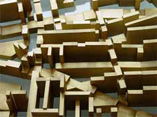 |
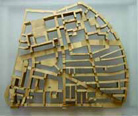 |
An image of the public space in the East Indonesian District
In the course of a hundred years much has changed since the original town
planning. Much new development has taken place. The public domain changed
face frequently in those hundred years. This can be seen in the model.
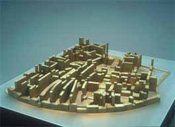 |
Apart from a recyclecreche I reconstructed a model of a excavation of a futuristic town plan. The model was made from take- aways unearthed in East Amsterdam. I referred to the revolution from garbage dump, which SOMETIME used to be its designation, via working-class neighbourhood to yuppie-areas. But also that in present dumping lay future raw materials.
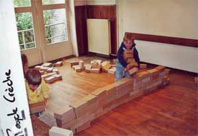 |
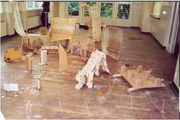 |
The soil sample card showed the discovery sites of parts of the model, or if you so wished, the garbage. And a reconstruction of a shift in the topographical centrepoint whence the neighbourhood had come from SOMETIME.
 |
Netty subsequently went ahead making prints OF paving in different neighbourhoods
in Amsterdam, in order to find out whether recognizable patterns existed,
instead of making prints ON the sidewalk. Was a certain paving characteristic
for a certain neighbourhood in a certain period? This resulted in interesting
projects, but nothing for the project cityscapeeast itself.
Because:
Cityscapeeast wanted to portray and compare patterns in urban landscapes
in order to discover connections in space and time. That was where the emphasis
was at that time.
It stayed quiet around cityscapeeast for some time.
Until Netty conceived the plan to make a print of the DAM square paving just before Crown Prince Willem-Alexander's wedding ceremony. The Dam, which had been paved anew specifically for the wedding, has a very distinct pattern. By making a print of the paving, Netty Gelijsteen intended to make a mobile square.
the making of the mobile Dam
 |
 |
Because not only was the interaction with the public at issue whilst making this mobile square.
 |
 |
As you can see, the tourists made their contribution diligently.
During an important ceremony, such as the wedding, the Dam is partly closed
to the public. A boundary arises between the private domain of the royal
family and the orange public.
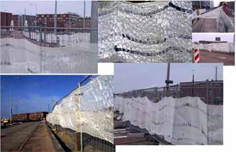 |
Netty wanted to create a mobile public centre, which would be accessible to everyone. You can see the Dam's pattern very well here. The dam was put into service at the White Square Fest. The mobile dam's first exposition was a matter of record. Many followed, but that's not relevant to this story.
I decided to make a landscape of garbage which had been collected just before and after the wedding ceremony. Garbage on the dam, just before and after the marriage was numbered, collected, photographed and incorporated in a sample card.
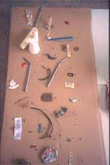 |
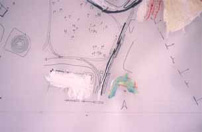 |
| the garbage on Jan 27th 2002 | the sample card |
After the wedding there was a partitioning in landscape and colour. In the private part of the Dam, only accessible to the invitees, there were islands of yellow and golden bits of paper.
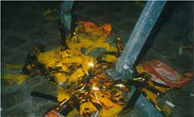 |
 |
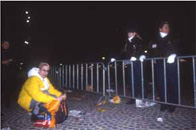 |
the royal litters. sample of the royal litters given to me by the two
policewomens at the other side of the second fence.
I have to admit that the royal family's invitees left quite a bit less garbage
than the people.
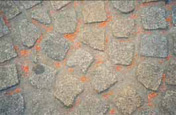 |
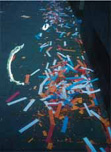 |
| near the dam at 15.00 hours | near the DAM at 16.00 hours |
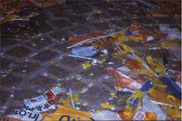 |
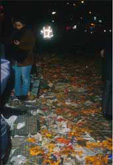 |
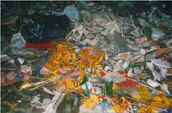 |
The public part was a wave of garbage consisting of orange and red-white-and-blue flags and bits of paper, orange coasters, orange shish kebab skewers, orange crowns, orange balls, orange chairs, news papers and plastic bags that had gathered against the fences. I can tell you that it was a particularly estranging and aesthetic experience. A wonderful landscape. No adverts on the Dam, mountains/heaps of garbage and fluorescent cleaners in between.
When the first fence was taken down the wind blew all the garbage to the palace. It reminded me of the run on the Bastille, animated with the garbage in the role of an army. The royal guard, instructed not to gave way, stood perfectly still. The garbage covered the red carpet. Finally the entrances of the palace were closed to prevent the occupation of the palace by dirt.
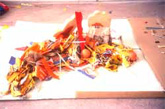 sample 3 of the public garbage copied precisely so in
my studio
sample 3 of the public garbage copied precisely so in
my studio
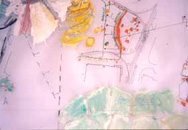 map with sample three. Using the map one can calculate
exactly how much garbage had accumulated, and where it had accumulated.
map with sample three. Using the map one can calculate
exactly how much garbage had accumulated, and where it had accumulated.
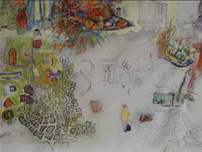 |
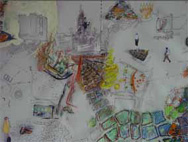 |
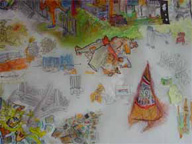 |
The garbage was processed in sculptures.
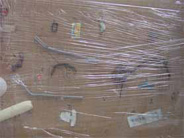 |
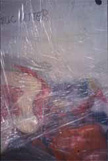 |
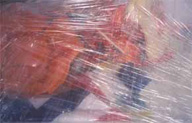 |
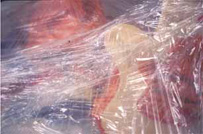 |
You can see that our national garbage product could easily be put in a OXFAM art calendar.
The Crown Prince marriage was not just any occasion. The significance is expressed in a column I wrote for a French journal:
France on the phone. If I want to write an article showing the
importance of networks and the exchange of information. My mind is on the
marriage of our Crown Prince to a woman from Argentina. Not just any woman,
but one who sheds tears when an accordion plays a tango of a farewell to
an old father. An old father? Yes, but one who held a responsible position
during the dictatorial Videla regime. Or were they tears of grief for the
poverty of 14 million people and the economic bankruptcy of her country?
Somehow I don't think so.
The catholic and protestant church officials, the Jewish Registrar - they
all speak soothing words about the absence of mum and dad who were not invited
to the wedding. A beautiful example of tolerant Holland.
The father says he didn't know, and she doesn't seem to have too much eye
for her people's situation. But appearances can be deceptive.
We see the world according to the way we have been raised and what we have
learnt in our peer groups. Me in mine and they in theirs. Will this marriage
open new possibilities? The abolition of the royal family, perhaps? Or would
that have been possible only of the Crown Prince had set his heart on Fatima
Bin Laden? Will this union expand their views and ours or is it merely a
consolidation of existing networks and ideas, nestling behind the security
of well -guarded fences that separate the public domain from the private
one?
The answer's in the future. Not in the past.
Would Maxima, the brand-new Princess of the Netherlands, have had the nerve
to say no in the townhall watched by the six million Dutch residents who
saw the wedding on television? And Prince Willem- Alexander? Against all
royal rules and organisation? Or was it too late and was their choice merely
a YES?
Don't we all have our own "royal families" and rules that decide
our "individual" choices? Don't we all say yes when sometimes
we mean no? Carried away in a moment of passion, weakness, unease or indifference?
How important do we find being able to talk to and communicate with other
people from different backgrounds, yet connected in time and space.
I don't know where unions and networks lead.
But I do know that Nelson Mandela was a guest at the wedding.(2)
We decided to bring the mobile dam and hence the mobile public centre
of The Netherlands to New York. After all we have a historical bond. Wasn't
New York founded by Dutch people? This time we didn't want to colonize or
annexe, but rather pull our weight (on cotton) regarding the discussion
on the historical event that had taken place on September 11th and it's
repercussions on the public domain in the urban landscape. At the same time
we would collect data in order to make new products.
In short, the Dutch public mobile centre was rolled up and stashed into
a backpack.
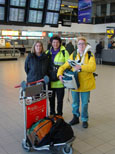 |
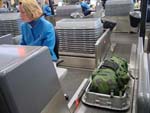 |
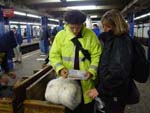 |
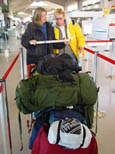 |
The mobile DAM in Schiphol airport, on a transport belt, in the underground, and going back.
Netty, armed with a letter issued by the council, stating this was an authentic print of the Dam, made with permission of the council, first met with Guy Tozzoli, founder of the WTC and Twin Towers in New York. Tozolli expounded on the WTC ideology, but couldn't give permission to make print of the sidewalk adjacent to the WTC. That entailed going to Lower Manhattan Development Company.
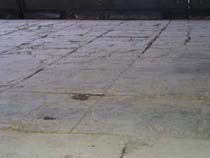
crackled sidewalk
Netty wanted to make a print of this crackle sidewalk, where all kind of cars and large material had fallen to bits. Said print she had wanted to divide in pieces of 9 by 9 cms, embroider on banners and give every WTC in the world such a banner, in order to enable people to touch the event with their hands. For we imprint ourselves continuously on the earth. Suddenly something like threethousand imprints of different backgrounds were reduced to one big implosion. She wanted to make that tangible.
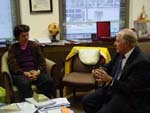 |
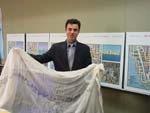 |
The LMDC accepted a dam canvas as a gift and added it to their memorial
archives.
Due to insurance technicalities they too couldn't give permission for a
print. A litany of meetings and authorities followed.
In the end six canvasses stayed behind in New York as solidified thoughts.
One at the LMDC (memorial archive), one at the Port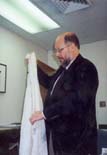 Authority New
York, and one at the World Financial Centre NY.
Authority New
York, and one at the World Financial Centre NY.
John Allen,St Paul´s
One canvas is hung in St Paul's Chapel, where the relief workers were
debriefed. The fire fighters who had lost four colleagues received a canvas.
At NINO's American Kitchen, where the relief workers got their food from,
a canvas was put in the store window. A security officer at Ground Zero
took a canvas home with him.
(In the end, the Dam as a whole was exhibited nowhere and the sidewalk was
not printed.)
The route that the mobile Dam took, in Netty's person, is documented on
video tape.
 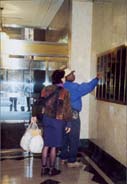 |
The route that the mobile Dam took, in Netty's person, is documented on video tape. |
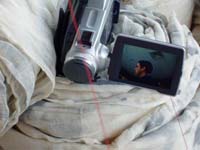 |
the video featuring the dam in New York at the exhibition in gallery AHOI |
A fragment of the DAM is located at the Dutch WTC director's , at the councilor's of inner city culture,
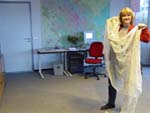
and in the IISG (International Institute for Social History located in Amsterdam) archive. Back in Europe Netty presented a "Dam piece" to the architectural firm Libeskind in Berlin (said firm is rebuilding the WTC). Slowly but surely the Dam is being spread over the world. Fortunately, the Mobile dam is quite accommodating.
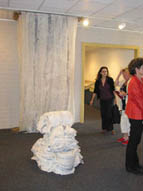 |
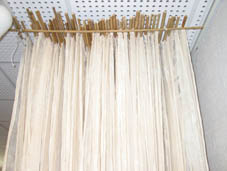 |
Whereas the Dam was a mere rolled up and visible couple of sheets of cloth at the IISG exhibition, last summer it was processed in an art installation.
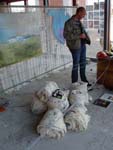 |
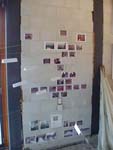 |
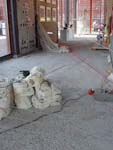 |
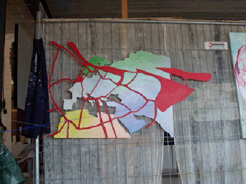 |
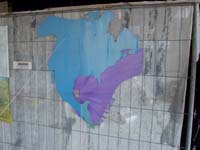 |
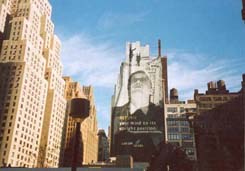
I won't discuss the choice of this traditional grid at length. She is still making calculations regarding this very complex area, which differs enormously per plot.
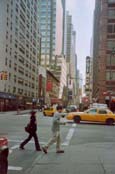 |
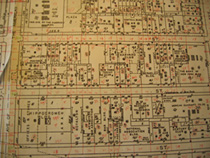 |
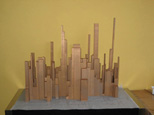 |
(We are all very curious what the urban factor will look like. Such a factor facilitates discussing heights of buildings in a different way. A more neutral language, which doesn't have it's origin in fear and enemy images. Such as: "we have to have very high buildings, otherwise the terrorists will have won". Enabling us to talk about what we want a city to look like.)
By means of my garbage landscapes I too try to offer a different view on events taking place in the public domain.
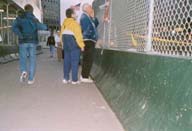 |
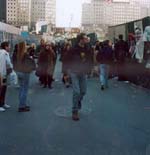 |
 |
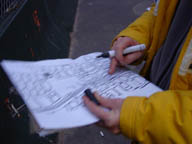 |
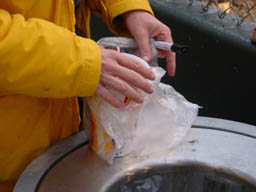 |
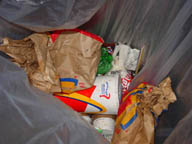 garbage in can
garbage in can
What struck me was the American size of the garbage. What I mean is that
it was large per item. Ranging from cups to plastic covers for whipped cream.
On average it was larger than in Europe.
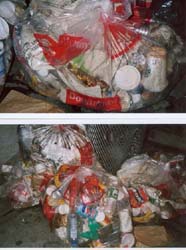
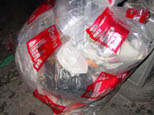 garbage bags
garbage bags
The garbage cans were emptied at noon and again at 19.00 hours. Note the
special garbage bags used for the ground zero garbage district.
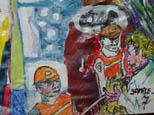 sample 7
sample 7
In the private part of the WTC, which is only accessible to builders and
security people, the same garbage cans with roughly the same contents could
be found.
The security people gave me the contents of their garbage can.
I had competition of other garbage collectors.
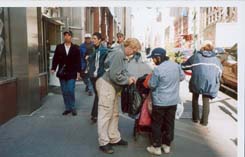
There was no essential difference compared to the garbage on the other side of the fence. Or possibly in the amount of coke cans. The identity which is adopted in the public domain and then discarded after the experience in that public space was chiefly limited to coffee cups, macdonald bags and plastic water bottles.
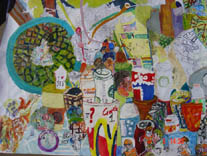 map with my interpretation of the garbage,
the locations, etc
map with my interpretation of the garbage,
the locations, etc
I don't know why my spatial awareness felt so sterile and distant. I remained a spectator looking at a flat piece of décor. As if the spatial organisation caused me not to experience the space. Just like Niagara Falls. There too I only experienced the water falls when I sailed there closely.
Where were the ruins of the WTC itself? What was left of it?
That part was most definitely privatised and behind a fence, but a fence
on Staten Island around Fresh Kills, the biggest garbage heap in the world,
according to the Americans. Just before the attack on the WTC the garbage
dump had been closed and a contest had been staged for landscape architects
to give the terrain a new destination and a public function in particular.
The WTC heap of rubble had to go somewhere however, and thus by way of exception
the mayor reopened hill 1/9/11, or rather the Amsterdam mountain of life
and death named as such by the CLUI (the institute of landscape architecture
and art, hosting the contest).
There everything was examined, usable items, remains for family members
were separated from the rubble and also everything that might lead to identification,
either now or in the future.
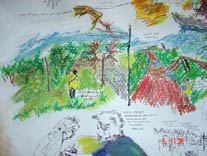 |
Sheila Metcalf, waterfront and open space division, Department of Cityplanning, NY. |
Sheila Metcalf, with the department of city planning and responsible for the transformation of Fresh Kills, showed me the place where I could get the best impression of fresh kills. But she could not give me permission to visit the area. Fed up to ask permission again Netty and I decided to give it a try.
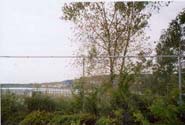 gate Fresh Kills
gate Fresh Kills
Having arrived there the gate was open. For our own piece of mind, Netty
and I asked permission from a couple of truck drivers.A little nervously
we started out on our journey.
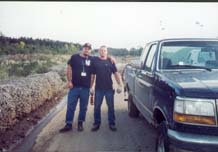 FsBarra and hiss boss
FsBarra and hiss boss
Soon we encountered Corey Fsbarra, a welder, who was happy to show us around. According to Corey, tourists had never before been interested in a garbage heap. We got into his car that was full of beer.
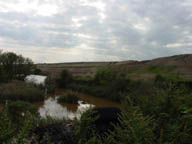 |
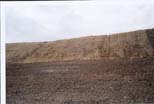 |
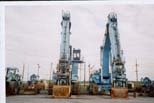 |
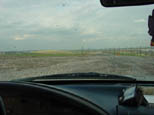 hill 1/9 on the right the fence of the FBI
hill 1/9 on the right the fence of the FBI
We passed a recently abandoned FBI village. After Corey had taken another
swig of beer and showed his ID we once again drove slowly upwards through
gates.
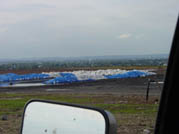 the last remains in bags
the last remains in bags
Rumour has it that these bags will be built into the foundation of the new
WTC complex. These remain might lead to identification in the future.
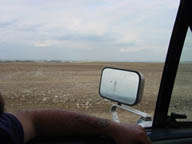 the combed out and raked part
the combed out and raked part
A sickly, sweetish, burnt odour rose towards us. Ultimately we stood on
a fine, brownish, sometimes black, chewing gum like sludge that had been
raked. A kind of lunar landscape. In the distance we saw the Manhattan skyline.
Like broken teeth. It was all very bizarre and emotional. Finally I had
the feeling to have paid my respect to the people killed , and after that
I had fewer problems with my being at the WTC crater. Needless to say maybe,
but for the record: I did not take any samples from that area, nor did I
make photographs.
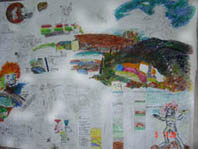 drawing
drawing
The right hand side of the drawing shows a cartoonish account of this adventure.
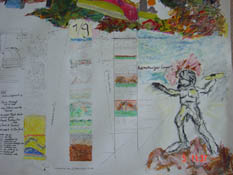 detail drawing
detail drawing
A cross-section of fresh kills hill 11/9 as I imagine a future garbageheapologist
would draw it. Garbage heaps are studied closely in order to find out in
what way the respective layers erodes. (This is how such a specialist noticed
that a hamburger layer had decomposed too slowly or not at all, because
a plastic layer had been dumped over it and it had hermetically sealed the
hamburger layer. You can see that in the cross-section.) Moreover, you can
see a small layer of unidentified strange matter. Until that time that layer
had always been missed. After research they claimed that this originated
from space. Together with astrologers they reconstructed a meteorite that
had sometime crashed on the Northern hemisphere and thus wiped out dinosaur
life.
Will this layer EVER change our view of the world, or rather consolidate
it in networks which nestle themselves behind the well guarded fences that
divide the public domain from the private.
(And, yes, sometimes landscapes change, but they are built upon again.)
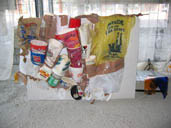 |
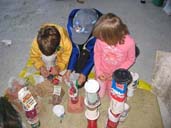 |
 |
Conclusion
In order to sketch you our route: we will call at Amsterdam South-East
and Berlin. And in cooperation with the National Archives we are preparing
to make a print of the Binnenhof in the Hague( the governmental residence)
just before Prinsjesdag (the day of the Queen's speech), and thus make a
Mobile Political Centre. If the latter happens we might be treading beyond
or context. More and more, a text image of hyperlinks is created, where
you can surf through with areas from where you can click to a next place.
This calls for questioning contextual boundaries.
Which (historical) lines can be broken and which links can be made?
I thank you for your attention.
References
Special thanks to: